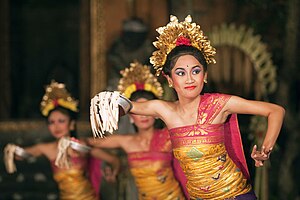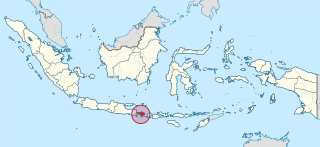
Bali is a province of Indonesia and the westernmost of the Lesser Sunda Islands. East of Java and west of Lombok, the province includes the island of Bali and a few smaller neighbouring islands, notably Nusa Penida, Nusa Lembongan, and Nusa Ceningan. The provincial capital, Denpasar, is the most populous city in the Lesser Sunda Islands and the second-largest, after Makassar, in Eastern Indonesia. Bali is the only Hindu-majority province in Indonesia, with 82.5% of the population adhering to Balinese Hinduism.

Puja or pooja is a worship ritual performed in the morning by Hindus to offer devotional homage and prayer to one or more deities, to host and honour a guest, or to spiritually celebrate an event. It may honour or celebrate the presence of special guest(s), or their memories after they die. The word "pūjā" is Sanskrit, and means reverence, honour, homage, adoration and worship. Puja, the loving offering of light, flowers, and water or food to the divine, is the essential ritual of Hinduism. For the worshipper, the divine is visible in the image, and the divinity sees the worshipper. The interaction between human and deity, between human and guru, is called darshan, seeing.

Kecak, known in Indonesian as tari kecak, is a form of Balinese hindu dance and music drama that was developed in the 1930s in Bali, Indonesia. Since its creation it has been performed primarily by men, with the very first women's kecak group starting in 2006. The dance is based on the story of the Ramayana and is traditionally performed in temples and villages across Bali.

Balinese Hinduism is the form of Hinduism practiced by the majority of the population of Bali. This is particularly associated with the Balinese people residing on the island, and represents a distinct form of Hindu worship incorporating local animism, ancestor worship or Pitru Paksha, and reverence for Buddhist saints or Bodhisattava.

Baris is a family of traditional war dances in Bali, Indonesia, accompanied by gamelan, in which dancers depict the feelings of a young warrior prior to battle, glorify the manhood of the triumphant Balinese warrior, and display the sublimity of his commanding presence. Baris derives its name from the word bebarisan, which literally means "line" or "file formation", referring to the soldiers who served the ancient rajas of Bali.
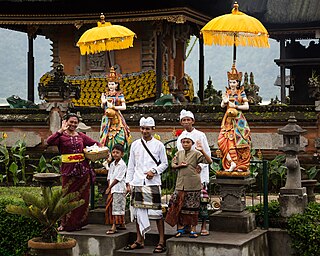
Hinduism in Indonesia, as of the 2010 census, is practised by about 1.7% of the total population, and by more than 83% of the population in Bali. Hinduism is one of the six official religions of Indonesia. Hinduism came to Indonesia in the 1st-century through traders, sailors, scholars and priests. A syncretic fusion of pre-existing Javanese culture and Hindu ideas, that from the 6th-century synthesized Buddhist ideas as well, evolved as the Indonesian version of Hinduism. These ideas continued to develop during the Srivijaya and Majapahit empires. About 1400 CE, these kingdoms were introduced to Islam from coast-based Muslim traders, and thereafter Hinduism mostly vanished from many of the islands of Indonesia.

Nyepi is a Balinese "Day of Silence" that is commemorated every Isakawarsa according to the Balinese calendar. It is a Hindu celebration mainly celebrated in Bali, Indonesia. Nyepi, a public holiday in Indonesia, is a day of silence, fasting and meditation for the Balinese. The day following Nyepi is also celebrated as New Year's Day. On this day, the youth of Bali in the village of Sesetan in South Bali practice the ceremony of Omed-omedan or 'The Kissing Ritual' to celebrate the new year. The same day is celebrated in India as Ugadi.

Balinese dance is an ancient dance tradition that is part of the religious and artistic expression among the Balinese people of Bali island, Indonesia. Balinese dance is dynamic, angular and intensely expressive. Balinese dancers express the stories of dance-drama through the bodily gestures including gestures of fingers, hands, head and eyes.

Dance in Indonesia reflects the country's diversity of ethnicities and cultures. There are more than 300 ethnic groups in Indonesia: Austronesian roots and Melanesian tribal forms are visible, and influences ranging from neighbouring Asian and even western styles through colonisation. Each ethnic group has its own dances: there are more than 3,000 original dance forms in Indonesia. The old traditions of dance and drama are being preserved in the many dance schools which flourish not only in the courts but also in the modern, government-run or supervised art academies.

Batuan is a village in Bali, Indonesia. It is noted for its artwork and style of painting which originated in the village in the 1930s and has since emerged into a major Balinese artistic style, known as a Batuan painting. It is a major painting center and contains a number of art galleries and cooperative art societies which have played a key role in promoting the art of Batuan. The village is also known for its performance of the ancient Gambuh dance, performed every Full Moon day.

Sanghyang is a sacred Balinese dance based on the premise that an unseen force enters the body of an entranced performer. The force, identified as hyang, is an important type of spiritual entity in ancient Indonesian mythology.

Sembah is an Indonesian greeting and gesture as a way of demonstrating respect and reverence. While performing the sembah, the person clasped their palms together solemnly in a prayer-like fashion called suhun or susuhun in Javanese; or menyusun jari sepuluh in Indonesian, and placed them in front of the chest, and moving the combined palms up to the chin, or all the way up until the thumbs touching the tip of the nose, while bowing slightly.

An Odalan is a Balinese village temple festival in Indonesia. It is an occasion when the Hindu village community comes together, invite the gods to visit them for three or more days, perform religious services together offering refreshments and entertainment. It is a periodic event, one that celebrates Balinese Hindu heritage and performance arts. The Odalan celebrations are a social occasion among Indonesian Hindus, and have historically contributed to the rich tradition of theatre and Balinese dance forms.

The cendrawasih dance is a Balinese dance which is performed by two female dancers and illustrates the mating rituals of the bird of paradise.
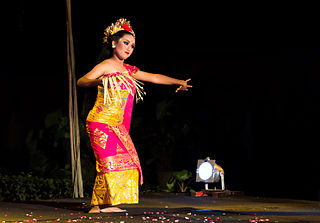
Panyembrama is a secular Balinese dance form designed by I Wayan Berata and first performed in 1971. It includes movements from several sacral Balinese dances, which it was intended to replace for performance in front of tourists.

The padmasana (Kawi and ultimately derived from the Sanskrit term for "lotus pose" is a type of shrine in a Balinese temple. The shrine is basically shaped like an empty throne on top of a pillar. Together with the Meru towers, the padmasana is a type of shrine reserved for the most important deity in Balinese Hinduism, usually to represent the Supreme God, also known as the Sang Hyang Widhi Wasa.

Pura Kehen is a Balinese Hindu temple located in Cempaga, Bangli Regency, Bali. The temple is set on the foot of a wooded hill, about 2 kilometres (1.2 mi) north of the town center. Established at least in the 13th-century, Pura Kehen was the royal temple of the Bangli Kingdom, now the Regency of Bangli.
Pura Dalem Sakenan is a pura located at the north-western shore of Serangan, a small island about 10 kilometres (6.2 mi) south of Denpasar, Bali. Pura Dalem Sakenan is dedicated to [rambut sedhana] and is associated with prosperity. Pura Dalem Sakenan is the focus temple of the 210-day Piodalan festival where in the past processions of pilgrims visited the island on foot or by traditional colorful wooden boats called jukung. With the construction of the bridge connecting the Serangan island with Bali as well as the reclamation of the island, the use of colorful jukung for pilgrimage has died out.

Pura Maospahit is a Balinese Hindu temple or pura located in Denpasar, Bali. The pura is known for its bare red brick architecture, reminiscent of the architecture of the 13th-century Majapahit Kingdom, hence the name. Pura Maospahit is the only pura in Bali which was built using a concept known as Panca Mandala where the most sacred area is situated at the center instead of at the direction of the mountain.
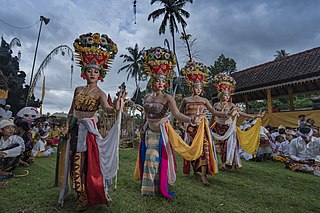
Rejang is a sacred Balinese dance, a sacrificial dance in which the girls offer themselves to the gods. It is usually held at the Hindu temple's of Klungkung Regency and Karangasem Regency in Bali, Indonesia. “Rejang” means “offering”, a dance to greet the gods that come down to the Earth. This dance is part of the sacred offering ceremonies, which all happen around about the same time on Bali’s ceremonial calendar.
